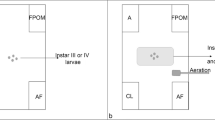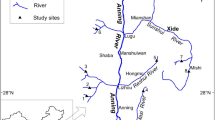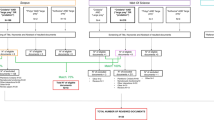Abstract
The behaviour of Diplonychus rusticum feeding on chironomid larvae has been investigated under laboratory conditions. Changes in the percentage of material extracted from prey indicated that feeding for the first two minutes enabled the predator to obtain approximately 33% of the available food; feeding for 10 minutes resulted in only 60% extraction. Comparing the percentage of each prey consumed by D. rusticum exposed to various prey densities, it was apparent that predators were more ‘wasteful’ and ate less of each prey as chironomid density increased. Because the rate of food intake declined as a greater proportion of each prey was extracted, predators exposed to high chironomid densities reduced the amount of each prey consumed thereby conforming to a simple optimal feeding model.
Similar content being viewed by others
References
Bailey, P. C. E., 1986a; The feeding behaviour of a sit-and-wait predator, Ranatra dispar (Heteroptera: Nepidae): optimal foraging and feeding dynamics. Oecologia (Berlin) 68: 291–297.
Bailey, P. C. E., 1986b. The feeding behaviour of a sit and wait predator Ranatra dispar (Heteroptera: Nepidae): the effect of prey density and age structure on the number of prey eaten. Ethology 72: 277–286.
Charnov, E. L., 1976. Optimal foraging: the marginal value theorem. Theor. Pop. Biol. 9: 129–136.
Cook, R. M. & B. J. Cockrell, 1978. Predator ingestion rate and its bearing on feeding and the theory of optimal diets. J. anim. Ecol. 47: 529–547.
Formanowicz, D. R. Jr., 1982. Foraging tactics of larvae of Dytiscus verticalis (Coleoptera: Dytiscidae): the assessment of prey density. J. anim. Ecol. 51: 757–767.
Giller, P. S., 1980. the control of handling time and its effects on the foraging strategy of a heteropteran predator, Notonecta. J. anim. Ecol.; 49: 699–712.
Griffiths, D., 1982. Tests of alternative models of prey consumption by predators, using ant-lion larvae. J. anim. Ecol. 52: 363–373.
Kruse, K. C., 1983. Optimal foraging by predaceous diving beetle larvae on toad tadpoles. Oecologia (Berlin) 58: 383–388.
Pyke, G. H., H. R. Pulliam & E. L. Charnov, 1977. Optimal foraging: a selective review of theory and tests. Quart. Rev. Biol. 52: 137–154.
Sih, A., 1980. Optimal foraging: partial consumption of prey. Am. Nat. 116: 282–290.
Victor, R. & Ugwoke, L. I., 1987. Preliminary studies on predation by Sphaerodema nepoides (Heteroptera: Belostomatidae). Hydrobiologia 154: 25–32.
Author information
Authors and Affiliations
Rights and permissions
About this article
Cite this article
Dudgeon, D. Feeding by the aquatic heteropteran, Diplonychus rusticum (Belostomatidae): an effect of prey density on meal size. Hydrobiologia 190, 93–96 (1990). https://doi.org/10.1007/BF00020691
Received:
Revised:
Accepted:
Issue Date:
DOI: https://doi.org/10.1007/BF00020691




